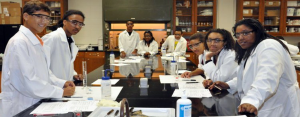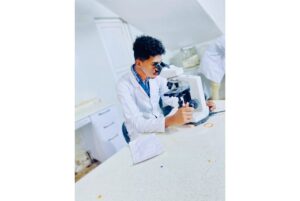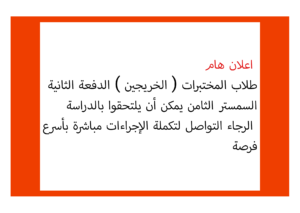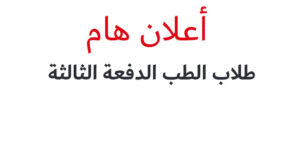Program of Medicine (MBBS)
This new university college is not so much meant to be another higher education institution as it is meant to contribute more substantially to the promotion, modernization and advancement of higher education values.
Our strategy is to modernize the curriculum content and curriculum structures in a way that would highlight the uniqueness of our institution and adopted the most modern quality standards according to the most sophisticated global systems.
Mission Statement
The mission of Zamzam university program of medicine- is to participate in the development and promotion of its community through high quality and cost-effective education, health service, and research
Vision statement
Zamzam University College (ZUC) MBBS program of medicine will be one of the leading Sudanese medical programs with an international reputation for its undergraduate, postgraduate and continuing professional development (CPD) program. We hope that this program will be seen as a key partner by the Federal Ministry of Health Services, Government, Charitable and private organizations for the development of new and innovative national training program for staff from the entire healthcare and associated professions.
We aim to be widely regarded as an example for engagement and effective joint working to the benefit of the public, patients and development of staff. We will encourage research and knowledge transfer
Objectives of the MBBS Program of Zamzam
General Objectives:
Core Competencies of Graduating Physician
Our general objective is to train and graduate doctors who can work in the different fields of Medicine to be:
- Good Health Manager and Leader
- Personal and Professional Developer
- Good Communicator
- Able to work in the different fields of Medicine
- Able to conduct scientific research to solve community health problems
- Equipped with professional ethics, communication skills and the necessary professional skills, to serve his/her patients and community.
- Able to establish an effective partnership with the different stakeholders to implement the reviewed and updated curriculum that serves the community and helps in solving community health problems.
Specific Objectives:
By the time of graduation, the graduate is expected to acquire the following competencies and characteristics: being able to:
- Be fully committed to the medical profession.
- Take a proper history to be able to diagnose a health problem.
- Conduct a proper physical and mental state examination to be able to assess the patient and diagnose his health problem.
- To interpret clinical findings in the history and examination to formulate a provisional diagnosis.
- Diagnose medical problems and disorders making use of the different available investigations; laboratory investigations, radiological investigations etc
- Prescribe and conduct proper treatment approaches to manage medical problems and disorders.
- Use a scientific knowledge in diagnosis and management of health problems, according to known methods of problem solving and integration, and explain the scientific structural (anatomical), functional (physiological, biochemical), morbid (microbiological, pathological), and therapeutic (pharmacological) background related to the problem.
- Manage emergencies e.g., road traffic accident, burns, toxins etc… and decide and act properly on cases needing referrals to specialized centres or personnel.
- Write a medical report about the referred cases.
- Deliver health promotion, preventive and rehabilitative activities to all members of communities.
- Observe in his/her practice, the health professional ethics which agree with the nations values, believes and norms (as stated by the Sudan Medical Council), and maintain good and honest relations with his/her patients, their families and his/her colleagues across all sectors involved in health.
- Respect patients’ rights and confidentiality.
- Acquire the skills of appropriate ethical counselling and advice in breaking news to the patients or their relatives in the different critical cases or conditions.
- Communicate with individuals and groups in health education and sessions.
- Adhere to (health team) approach, acting as efficient member, capable of its leadership, dividing labour and responsibilities among the members, and ensuring both effectiveness and homogeneity among the members.
- Communicate and collaborate with members of the health team in a way that helps to achieve the objectives of the health care for individuals and the communities.
- Encourage community participation and act in recruiting various sectors in defining heath and health related problems, planning and providing suitable solutions, recognizing the community believes, ethics and traditional practices.
- Administer a health “unit” or “centre” efficiently according to scientific, medical, statistical, economic and legal bases.
- Continue to consider elements of efficiently, costing and economic implications in his/her diagnostic and therapeutic choices.
- Acquire the skills of teaching, learning and communication efficiently to carry out his/her duties in health education and in winning the confidence of patients and their families and societies.
- Acquire the skills of independent learning, and contribute to availing opportunities for planning and implementing continuous education activities to upgrade his/her own abilities (specialize, lifelong learner) and those of his/her colleagues in the health team.
- Carry health or health-related research, alone or with a health team, using scientific methods known in such activities.
- Observe the research ethics.
- Use computer in word processing, statistics and graphics to achieve success in other objectives of his/her career.
- Continue, recognizing the needs of the society for certain specialties, particularly general practice and family medicine.
- Have the skills of writing and/or appraising a scientific article.
- Manage and contribute in the management of disasters
- The Zamzam college administration shall conduct continuous evaluation for all components of the teaching-learning process including evaluation of the academic programs, the teachers and student’s performance
Section 1: Educational Approach
Outline of the Curriculum
The proposed curriculum follows an outcome-based prescriptive model, but instead of the spiral design, it utilizes a layered approach to the acquisition of medical knowledge. Despite being detailed by disciplines, it employs horizontal integration via collaborative and coordinated instruction between disciplines within each layer/phase. A degree of vertical integration is included in the form of generally highlighting and occasionally elaborating on the clinical relevancies of basic medical sciences in early phases, and re-discussing the fundamental concepts underlying clinical medicine and practice in the clerkship phase.
Some elements of the curriculum are dispersed and placed where relevant to the prior knowledge of students or according to need, while others run longitudinally across phases as they serve the acquisition of competencies and qualities that are central to the education of future physicians, mainly related to ethics and professionalism, critical thinking, scientific method and research, community medicine, and practical skills.
1.1 Structure and organization
The curriculum will be delivered in five academic years divided into 10 semesters. It is organized into the following four phases:
Phase I: Foundation for Medical Practice
preparatory courses delivered in semester one to ensure that students have the essential background of general sciences and the required proficiency level in English language necessary for attending medical school.
Phase II: Foundation of Basic Sciences:
This phase extends over the period of three semesters (2-4). The second phase deals with pathophysiology & the mechanism of disease. In addition, other courses develop clinical skills and address the psycho-social aspects of medicine. It has a number of subjects and modules including the basic medical sciences. In addition to university required subjects, the goal of this phase is to provide the opportunity to learn basic science in depth and to learn introductory aspects of clinical medicine.
It is organized around a series of organ system-based courses, each presented by a multidisciplinary team of faculty members. Within each course, normal physiology, anatomy, biochemistry of the system is presented in conjunction with the pathology, microbiology of common diseases, and medical and pharmacologic approaches to diagnosis and treatment. Each course uses a variety of formats, including case presentations, lectures, small group discussions, laboratory sessions, computer-aided instruction, and independent study.
Phase III: Clinical preparation- pre-clerkship:
delivered in semester 5 and 6. The third pre-clerkship phase covers the basic clinical skills, forensic medicine & public health. It prepares the students for clinical rotations and the residency program. During this course, students are assigned to a clinic to reinforce history and physical examination skills learned in the college.
Phase IV Phase III: Clinical Clerkship
designed to ensure adequate exposure to various clinical disciplines and proper clinical training and participation in patient care. For the remaining 4 semesters, students receive instruction about essential clinical topics and disease conditions, supported by clinical training in hospitals, clinical skills and simulation labs, community clinics and primary health centres; as well as fulfilling a residency attachment period in preparation for the postgraduate foundation program/ internship.
In addition to the mandatory core courses provided each semester, a number of elective courses and clinical residencies (both credit & non-credit ones) will be designed and offered for our students to select from, thus allowing them to take charge of the range of expertise and skills they could explore and acquire in preparation for their postgraduate training and career of choice.
1.2 Teaching and learning
As there is a wide variety of learning methods and styles in medical education, the curriculum should reflect the diversity and allow the reinforcement of the learning experience of students by presenting learning materials through different methods of instruction and educational support:
- Lectures
- Labs
- Small group activities
- Presentations and seminars
- Case-based/Problem based learning (PBL)
- Team based learning (TBL)
- Simulation and clinical skills practice
- Computer-assisted learning (virtual/simulation applications, online materials, etc)
- Clinical rounds
Emphasis on guiding our students to develop self-directed learning behaviour and practices should direct the instruction and the design of learning situations.
1.3 Assessment
Range of Assessments used in University College of Zamzam
Evaluation of students
- Assessment: Examinations on all domains of learning are conducted throughout the year employing both formative & summative assessment types. Although the Formative types are meant for diagnosis & feedback, a percentage not exceeding 20% of the final mark can be calculated from these tests and considered as a form of continuous assessment.
- Assessment Tools: used for both types of formative & Summative types of assessment are:
- Written
- MCQs: As single best answer or single correct answer.
- SAQs short answer questions (As structured as possible). Applied where appropriate
- CCSs: Clinical case scenarios (in the form of modified essay questions as far as possible).
- OSPE/ Spotters: Where appropriate.
- OSCE: Where appropriate.
- CLINICAL: Workplace-based assessment utilizing the Mini CLEX.
1.4 Quality management
To ensure the quality of evaluation, the process will be managed by an assessment committee. The roles of the committee are:
- Set the guidelines for quality assurance of all the steps of the evaluation process (measurement-evaluation-interpretation-decisions).
- Follow the steps of evaluation to ensure that they are conducted in accordance with the guidelines & regulations.
- Supervise the process of checking assessment tools for their validity, reliability & quality before they are used.
- Supervise the process of results & exam analysis to detect faults & abnormalities.
- Supervise the process of correction & normalization of exam results when faults & abnormalities are detected.
- Develops tools & forms for pre-test quality assurance & post-test analysis.
- Organize assessment & evaluation training programs for faculty in collaboration with the Educational Development Unit.
- Calculation of grades: Grades are going to be calculated based on a pre-set scale provided that examinations are adjusted in a way that guarantees that a minimally competent student pass all tests & that the interpretation of results are therefore criterion-referenced.
1.5 Grading scale:
The five-point grading scale according to the following table is applied:
| المعدل التراكمي | التقدير |
| أكبر من أو يساوي 80% | ممتاز |
| أكبر من أو يساوي 70% واقل من 80% | جيد جدا |
| أكبر من أو يساوي 60% واقل من 70% | جيد |
| أكبر من أو يساوي 50% واقل من 60% | مقبول |
Student’s Promotion:
For a student to be promoted from one year to the next he/she must fulfil the following criteria:
- Pass at least 2/3 of the educational units covered during the year (two semesters).
- Clear ALL the failed major educational units in the supplementary exams (major educational units are the units which are completed during the year & are not part of a longitudinal course, subject or discipline).
- Pass ALL the longitudinal educational units which finish during the particular year.
1.6. Implementation and Evaluation Strategies
To bring our proposed curriculum into being, a specific curriculum implementation process is being developed, entailing the creation of a curriculum management/ steering committee designated by the Dean, and chaired by the program director. This committee will oversee the application of the implementation timetable and the creation of focus teams for implementing each element of the curricular plan, as well as establishing a curricular revision and evaluation process.
An evaluation process will be running along with all stages of implementation. An established system of evaluation will employ students’ academic performance (formative assessment and exams grades), students’ and faculty satisfaction surveys (about specific courses and the whole curriculum), performance of graduates on licensing exams and other standardized exams, postgraduate training track records of graduates, as well as tracking the impact of the curriculum on the health service sector and the community
SECTION 2: CURRICULUM STRUCTURE
Curriculum Plan
First Year:
| Phase | year & Semester | Educational Unit | Code | Total | |
| Phase I:
Foundation for Medical Practice |
First Year
Semester I |
Islamic culture I | ISL111 | 2 | 1 |
| Arabic language I | ARB112 | 2 | 1 | ||
| English Language I | ENG113 | 2 | 1 | ||
| Sudanese Studies | SDS114 | 2 | 0 | ||
| Human Biology | HBL115 | 2 | 2 | ||
| Mathematics & Medical Physics | MMP116 | 2 | 2 | ||
| Chemistry | CHM117 | 2 | 2 | ||
| Total Credit Hours | 13 | 7 | |||
| Phase | year & Semester | Educational Unit | Code | Total | |
| Phase II:
Foundation of Basic Sciences |
First Year
Semester 2 |
Islamic culture II | ISL121 | 2 | 0 |
| Arabic language II
|
ARB122
|
2 | 0 | ||
| English Language II | ENG123 | 2 | 1 | ||
| Introductory Biochemistry | BIO124 | 2 | 1 | ||
| Introductory Gross Anatomy (Embryology) | EMB125 | 2 | 1 | ||
| Man & his environment | MEV126 | 2 | 1 | ||
| Basic Histology | HIS127 | 1 | 1 | ||
|
Total Credit Hours |
13 | 5 | |||
| 18 | |||||
Second Year:
| Phase | year & Semester | Educational Unit | Code | Total | |
| Phase II:
Foundation of Basic Sciences |
Second Year
Semester 3 |
Respiratory System | RES211 | 2 | 2 |
| Cardiovascular System | CVS212 | 3 | 2 | ||
| Introduction to Microbiology | MIC213 | 3 | 1 | ||
| Introduction to Pathology | PAT214 | 3 | 1 | ||
| Introduction to Pharmacology I | PHR215 | 2 | 0 | ||
| Total Credit Hours | 13 | 6 | |||
| 19 | |||||
| Phase | Year & Semester | Educational Unit | Code | Total | |
| Phase II:
Foundation of Basic Sciences |
Second Year
Semester 4 |
Blood & Immune | BLI221 | 4 | 1 |
| Gastro Intestinal System | GIT222 | 3 | 2 | ||
| Endocrine & Metabolism | END223 | 3 | 1 | ||
| Urogenital System | URG224 | 2 | 1 | ||
| Medical Informatics | MIF225 | 1 | 1 | ||
| Principles of Research | RSH226 | 1 | 1 | ||
| Total Credit Hours | 14 | 7 | |||
| 21 | |||||
Third Year:
| Phase | year & Semester | Educational Unit | Code | Total | |
|
Phase III Clinical Preparation |
Third Year Semester 5 |
Community Medicine I (Epidemiology) | EPD311 | 2 | 0 |
| Musculoskeletal system | MSC312 | 3 | 2 | ||
| Head & Neck | HDN313 | 2 | 3 | ||
| Forensic Medicine | FRN314 | 2 | 1 | ||
| Applied Medical Science | AMD315 | 1 | 1 | ||
|
Total Credit Hours |
10 | 7 | |||
| 17 | |||||
| Phase | year & Semester | Educational Unit | Code | Total | |
|
Phase III Clinical Preparation |
Third Year Semester 6
|
Central Nervous System | CNS321 | 4 | 3 |
| Evidence-based healthcare | EBH 322 | 2 | 2 | ||
| Basic clinical skills | BCS323 | 1 | 3 | ||
| Clinical Pharmacology II (Therapeutics) | THP324 | 3 | 0 | ||
| Medical Professionalism | MDP325
|
2 | 0 | ||
| Total Credit Hours | 12 | 8 | |||
| 20 | |||||
Fourth Year:
| Educational Unit | Code | Total | |||
| Phase IV | Year four
Semester 7 |
Community medicine II
(Primary Health Care)
|
PHC411
|
3 | 1 |
| Internal Medicine I | MED412
|
3 | 3 | ||
| Medical Professionalism II (Applied Ethics) | ETH413 | 3 | 1 | ||
| Surgery I | SUR414 | 2 | 2 | ||
| Total Credit Hours | 11
|
7 | |||
| 18
|
|||||
| Phase | year & Semester | Educational Unit | Code | Total | |
|
Phase IV Clinical Clerkship |
Fourth Year Semester 8 |
Ophthalmology. | OPT421 | 2 | 3 |
| Paediatrics I | PED422
|
4 | 3 | ||
| Obstetrics & Gynaecology I | OBG423 | 2 | 2 | ||
| Dermatology | DRM424 | 1 | 1 | ||
| Psychiatry | PSY425 | 2 | 1 | ||
| Total Credit Hours | 11 | 10 | |||
| 21 | |||||
Fifth Year:
| Phase | Year & Semester | Educational Unit | Code | Total | |
|
Phase IV Clinical Clerkship |
Fifth Year Semester 9 |
Surgery II | SRG511 | 2 | 3 |
| Internal Medicine II | MED512 | 2 | 2 | ||
| Obstetrics & Gynaecology II | OBG513 | 1 | 2 | ||
| Pediatrics II | PED514 | 1 | 2 | ||
| Otolaryngology (ENT) | ENT515 | 1 | 1 | ||
| Anaesthesia & Intensive Care
|
ANES516 | 2 | 1 | ||
| Total Credit Hours | 9 | 11 | |||
| 20 | |||||
| Phase | year & Semester | Educational Unit | Code | Total | |
| Medical Imaging | MMG521 | 1 | 1 | ||
| Phase IV
Clinical Clerkship |
Fifth Year
Semester 10 |
Surgery III | SRG522 | 0 | 6 |
| Internal Medicine III | MED523 | 0 | 6 | ||
| Paediatrics III | PED524 | 0 | 4 | ||
| Obstetrics & Gynaecology III | OBS525 | 0 | 4 | ||
| Total Credit Hours | 1 | 20 | |||
| 21 | |||||
- Total Credit Hours= 197 (103 + 94)
First Year:
Semester 1
Phase 1 – Foundation for Medical Practice
Introduction
Phase 1 is a one semester educational unit giving an introduction to the basic principles underlying the practice of medicine. These basic principles are Anatomical Principles, Biomedical Principles,
Aims
The aims of this phase are to:
- introduce students to basic scientific principles, languages & cultural issues as a foundation for professional practice
- develop in the student an understanding of the basic principles of normal structure & function of the human body
- introduce students to approaches to study and learning including the understanding of their learning style, the use of self-directed learning, problem solving and the use of new technologies and e-learning
- prepare students for entry to Phase 2 of the curriculum
Islamic Culture I الثقافة الإسلامية
| Islamic Culture I | ||
| Course Number & Code: ISL111 | Course Name: Islamic Culture I | Year: First
Semester: One |
| Credit hour: 2 hrs. (2+0) | Duration: 16 Weeks | Mode: Longitudinal |
| Coordinators: | ||






